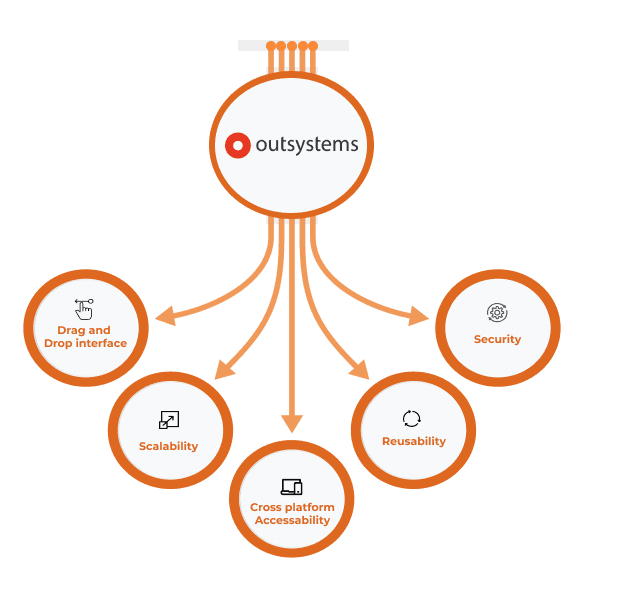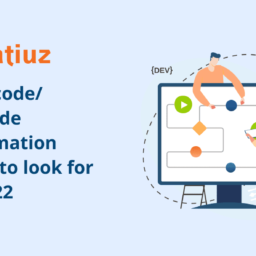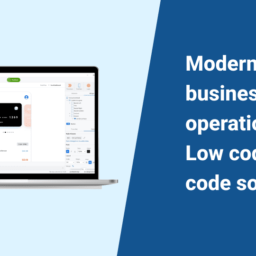Many business users among other professionals in the digital workplace are choosing low code no code applications as their technology of choice, making inroads as a major approach for assisting digital business transformation through swift application deployment. One of the major reasons for such preference is the ability to speed up application development by up to ten times when compared to conventional methods. Low code/ No-Code platforms have been gaining popularity for more than a decade now.
With the help of low-code development platforms, digital business transformation can be supported by accelerating application delivery.
As opposed to traditional line-by-line programming, low-code platforms use visual, declarative techniques. With this technology, it is easier to build both web-based and mobile applications for those with limited experience. In days or weeks, individuals or small groups can experiment, prototype, and produce apps.
What makes low code platforms compatible with no code?
Low code/ no-code development is a slide-based (drag-and-drop) strategy for app development that minimizes the amount of manual coding as much as possible. These structures enable the development of websites and apps with a quicker turnaround and fewer resources involved. One of the major reasons for the low code/no-code platform’s success is the ability to create custom pieces for functionality that can be used for multiple projects. This accelerates software development ten times faster than traditional methods.
Low code/no-code platforms integrate all the work behind the scenes. The user connects reusable components (which contain the actual code) that represent particular steps or capabilities and links them together to create an automated workflow. Imagine a low code platform a box full of lego pieces that you can use or you can create a new lego piece that you can replicate when required.
One such platform that is gaining popularity from business users and coders alike is OutSystems. A platform often goes hand in hand with the traditional development methods. It allows developers to connect components and third-party application program interfaces (APIs) via a user-friendly graphical user interface (GUI). The platforms also provide features such as prototyping, testing, and deployment.

Low Code No Code: what can be built
- Application for Business
- Automation of applications
- Applications for the website and mobile devices
- Applications that need modernization
- Workspace application
- Dashboards for Analytics and Data
- Engines and Workflow/Processes
- Portals/Gateways
The massive rise of Outsystems can be attributed to the following nine factors/benefits:
A key reason for the adoption of low code no code development is to accelerate delivery and improve innovation. Faster deliverability and improved innovation are two major aspects driving the adoption of the low-code development methodology.
Cost-Effective
Low code/ No code applications necessitate far fewer engineering work, cutting costs over time.
Growth in productivity
Low code development platforms enable IT teams to become more productive by accelerating application development. The robust adaptability of low code no code platforms also helps them to deploy solutions and strategies more quickly.
Easy-to-understand process
Low code development platforms enable non-technical users to create and modify apps, features, and processes without interrupting in-house IT teams.
Risk control
Low code no code enables you to keep track of all risk management activities in a unified platform, helping you meet deadlines and remain compliant. Data security can be enhanced by using a solid low code application development framework.
Flexibility
Low code enables users to create customized structures and operating systems. These platforms have features that have been thoroughly tested by several implementations, reducing the risk of bugs or security problems.
Simple deployment
If an issue arises, with low code you can roll back all changes to a stable version with just one click and fix it quickly.
Maintenance is reduced
With low-code development, the monotonous repair work is abstracted to reduce the strain of system maintenance. Now that components are standardized, pretested, and ready-made, there are far fewer defects and compatibility issues to contend with.
Prototyping in Speed
Low code application development has the advantage of allowing non-coders to swiftly prototype solutions. Without the involvement of conventional software development staff, these solutions can be tested, assessed, and modified.
Bridging the gap in Technology
Low code platforms allow for greater flexibility and more accessible development cycles. They also help to democratize and expedite innovation by bridging the technological barrier. Low-code platforms’ latest visual programming approaches enable business users to design and improve on solutions to increase their efficiency and productivity.
Outsystems is useful for SMEs and large enterprises alike.
Businesses looking to get started are choosing low code over lengthy hiring processes and delayed deployments. Users with little or no coding skills may be able to update their apps using the ‘click’ or ‘drag and drop’ menus. It’s also a great opportunity for small and medium enterprises to move quickly with minimal investment by developing and maintaining apps at a low cost.
In recent times, the use of low code solutions has expanded among major corporations. Low code platforms have grown tremendously as a result of their proclivity for integrating business sectors. Low code has been a huge accomplishment in closing that gap in modernizing.
The improved adaptability of low code development benefits large enterprises by enabling them to adopt cutting-edge technologies along all different disciplines. Low code automation platforms enable you to build and deploy process applications across your organization on any device without coding. Low code consumption also led to increased process automation and application agility.
In today’s fast-paced world, low code/ no code platforms enable both small and large businesses to scale more quickly. It promotes departmental collaboration and innovation in the pursuit of making aspirations a reality through realistic means of implementation.
Ignatiuz created a shop floor scheduling application using Outsystem Low Code
Shop floor scheduling involves setting up a schedule, prioritizing, tracking, and reporting the various resources of a shop floor, such as people, tools, materials, and inventory.
From project management through go-live, the Ignatiuz solution was developed in Outsystems in about 4- 6 weeks. Using a low-code no code platform for creating a solution can quickly turn around and is secure. Using Outsystems, Ignatiuz could build serious applications quickly and efficiently. By combining an industry-leading AI-based assistant with a visual design environment, applications can be created in days instead of months or years.
A timetable for the shopfloor is created based on availability and pre-defined line requirements. The programme is simple to use because the manager only needs to enter dates and select required lines.
We partner with our clients on no-risk & no-cost pilot and proof of concept engagements, to demonstrate the high effectiveness and ROI of modern process automation solutions. Click here to know how you could benefit from no-risk & no-cost pilot.












